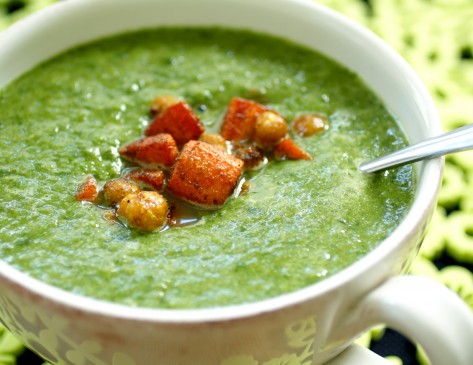Spring Green Soup

Is there such a thing as being “good” at social media? If so, I’m the opposite. Yet, in spite of my minimal activity on Facebook and Twitter, etc., I sometimes get to experience the benefits of social media first-hand. It happened just recently when Karen Deyle Miller, new to Vermont, contacted me about joining DCCC. She is a facebook friend with Crescent Dragonwagon, a friend of mine who had “liked” my posting about the club’s wok portrait session. And now Karen is a member. Nice, huh?
Not missing a beat, Karen has jumped right into Jerusalem, our current pick. She quickly discovered that some of the key spices and spice blends used in the book are sold at Healthy Living Market in Burlington, including ras el hanout. Karen offered to pick up some ras el hanout and deliver it to me at a mid-way meet-up spot. Since this spice blend is used just once in the book, I hadn’t considered driving out of my way to track it down, but who can refuse an opportunity to try something new, something you’ve never heard of, when it’s delivered practically to your doorstep.

Ras el Hanout
I’m glad I took Karen up on her offer. Its single use in the book—Watercress & Chickpea Soup with Rose Water & Ras el Hanout—is alone worth seeking out the spice blend. Though “pigging out on” or “indulging in” soup, let alone vegetarian soup, might sound improbable, it is exactly what this dish will have you doing. It is that good.
This green soup is constructed in two parts: a pureed base made of sautéed onions and grated ginger (and plenty of it, too), watercress, spinach, chickpeas, vegetable stock, and rosewater; and a spiced and roasted carrot and chickpea topping, which is where the ras el hanout comes into play. The soup is optionally finished with a small dollop of Greek yogurt.
Yotam Ottolenghi and Sami Tamimi, authors of Jerusalem, describe ras el hanout as a “sweet-and-heady” mix that consists of sweet and hot spices that are toasted and ground. To my olfactories, the smell of the batch I got is reminiscent of curry, but sweeter. There is no set recipe, but clearly Ottolenghi and Tamimi believe cinnamon should be included. (If the blend you find does not contain cinnamon, they say to make sure to add some.)
Besides serving as an excellent introduction to ras el hanout, this soup has gotten me over my fear of rose water—an unfounded fear that it will take over and dominate everything it touches. Here it counters the spicy heat of the large amount of fresh ginger, making the soup more elegant and balanced than it would be without it, and contributes to its heady aroma. I have to admit I wimped out a bit and used just half the amount called for. I should have trusted the authors’ palates. The more recipes I and other club members try, it’s clear that the flavors in this book are faultless.
